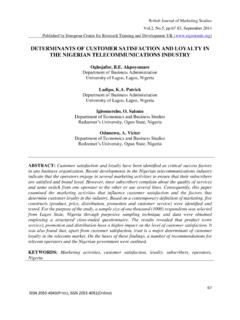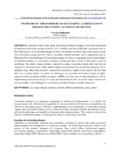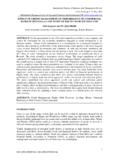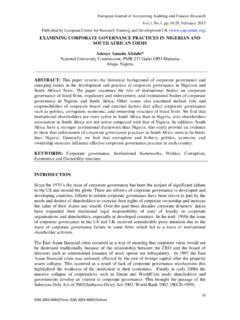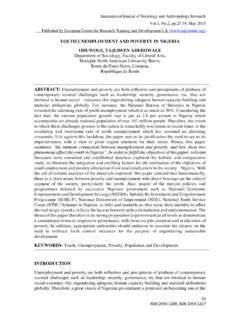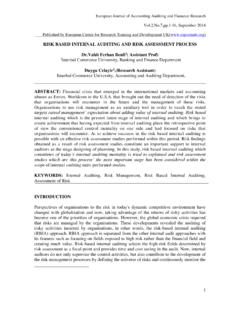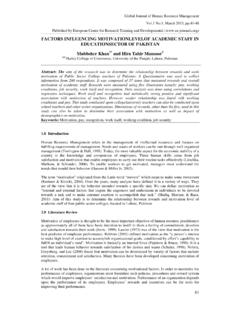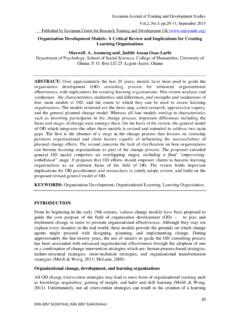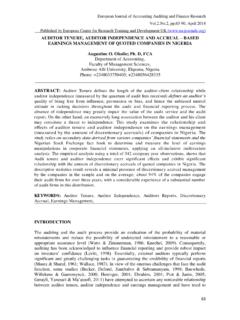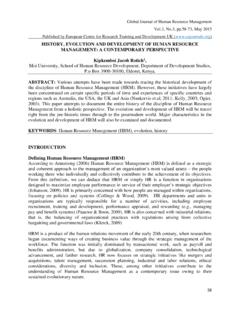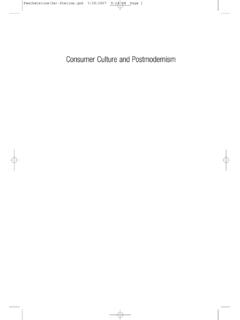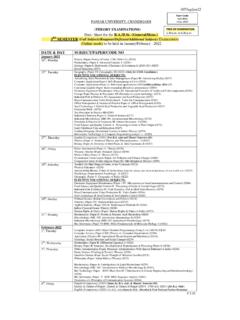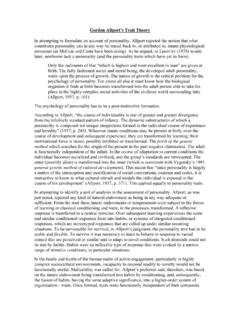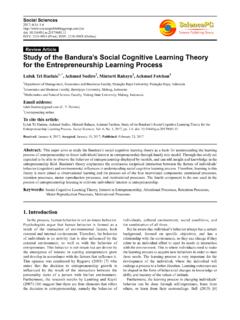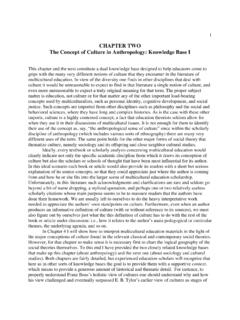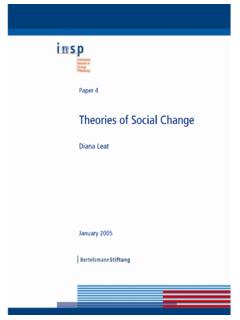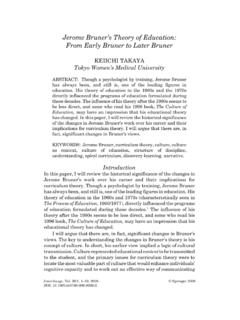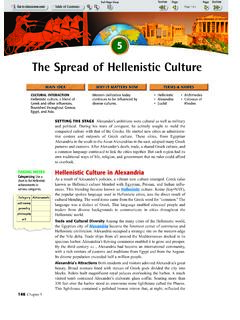Transcription of CLASSICAL ORGANIZATION THEORY: FROM GENERIC …
1 International Journal of Business and Management Review , , , February 2016 ___Published by European Centre for Research Training and Development UK ( ) 87 ISSN: 2052-6393(Print), ISSN: 2052-6407(Online) CLASSICAL ORGANIZATION theory : FROM GENERIC MANAGEMENT OF SOCRATES TO BUREAUCRACY OF WEBER zg r nday PhD student, Yeditepe University Department of Business Administration ABSTRACT: ORGANIZATION is a relatively young science in comparison with the other scientific disciplines. (Ivanko, 2013) Accounts of the growth of organizational theory usually start with Taylor and Weber, but, as Scott (1987) mentions, organizations were present in the old civilizations which goes back to Sumerians (5000, BC) and which experiences its maturation phase with Taylor, Fayol and Weber, continuing to come up to present with modern management methods and principles. The modern ORGANIZATION may be the most crucial innovation of the past 100 years and it is a theory which will never complete its evolution as the human being continues to exist.
2 Understanding how organizations work has been the focus of scientists and scholars until the early part of the 20th century. Just as organizations have evolved, so to have the theories explaining them. These theories can be divided into 9 different schools of thought (Shafritz, Ott, Jang, 2005): CLASSICAL ORGANIZATION theory , Neoclassical ORGANIZATION theory , Human Resource theory , or the Organizational Behavior Perspective, Modern Structural ORGANIZATION theory , Organizational Economics theory , Power and Politics ORGANIZATION theory , Organizational Culture theory , Reform Though Changes in Organizational Culture and Theories of Organizations and Environments. This paper will concentrate on the very beginning theory namely CLASSICAL ORGANIZATION theory and is divided as follows. The introduction talks about the developments of the ORGANIZATION and ORGANIZATION theory from its early stages with detailed definitions.
3 In section 2, theoretical roots in other words literature review on the subject will be presented. At further section, by looking at the perspectives of the 15 pioneering people (Socrates, Smith, Owen & Babbage, McCallum, Towne, Watt, Metcalfe, Fayol, Taylor, Gantt, Gilbreths, Barth, Weber, and Gulick) main principles of the CLASSICAL ORGANIZATION theory are presented one by one. Section 4 mentions strengths and weaknesses of the CLASSICAL organizational theory and section 5 discusses and concludes the paper. KEYWORDS: CLASSICAL , ORGANIZATION , ORGANIZATION theory . INTRODUCTION Man is intent on describing himself into a web of collectivized patterns. ``Modern man has learned to accommodate himself to a world increasingly organized. The trend toward ever more explicit and consciously drawn relationships is profound and sweeping; it is marked by depth no less than by extension.`` This comment by Seidenberg summarizes the influence of ORGANIZATION in many shapes of human activity.
4 Some of the reasons for hectic organizational activity are found in the main transitions which revolutionized our society, shifting it from a rural culture, to a culture based on technology, industry, and the city. From these shifts, a way of life occurred and characterized by the proximity and dependency of people on each other. Proximity and dependency, as conditions of social life, harbor the threats of human conflict, capricious antisocial behavior, instability of International Journal of Business and Management Review , , , February 2016 ___Published by European Centre for Research Training and Development UK ( ) 88 ISSN: 2052-6393(Print), ISSN: 2052-6407(Online) human relationships, and uncertainty about the nature of the social structure with its concomitant roles. Of course, these threats to social integrity are still exist to some degree in all societies, ranging from the primitive to the modern.
5 But, these threats become serious when the harmonious functioning of a society acts upon the maintenance of a highly intricate, delicately balanced shape of human collaboration. The civilization we have generated depends on the preservation of a precarious balance. Hence, disrupting forces impinging on this shaky form of collaboration must be prohibited or minimized. Traditionally ORGANIZATION is seen as a intermediary for accomplishing goals and objectives. While this approach is nifty, it tends to obscure the inner workings and internal aims of ORGANIZATION itself. Another fruitful way of behaving ORGANIZATION is as a mechanism having the ultimate aim of offsetting those forces which undermine human collaboration. In this approach, ORGANIZATION sloping towards to minimize conflict, and to lessen the meaning of individual behavior which deviates from values that the ORGANIZATION has established as worthwhile.
6 Further, ORGANIZATION increases stability in human relationships by decreasing uncertainty regarding the nature of the system's structure and the human roles which are inherent to it. Parallel to this point, ORGANIZATION enhances the predictability of human action, because it limits the number of behavioral alternatives available to an individual. (Scott, 1961) Furthermore, ORGANIZATION has built-in safeguards. Besides prescribing acceptable shapes of behavior for those who elect to submit to it, ORGANIZATION is also capable to counterbalance the effects of human action which transcends its established ways. Few segments of society have engaged in organizing more strongly than business. The reason is clear. Business depends on what ORGANIZATION offers. Business requires a system of relationships among functions' it requ stabires stability, continuity, and predictability in its internal activities and external contacts.
7 Business also appears to need harmonious relationships between the people and processes which creates it. In other words, a business ORGANIZATION has to be free, relatively, from destructive tendencies which may be caused by divergent interests. (Scott, 1961) As a main principle for meeting these needs build upon administrative science. A major element of this science is ORGANIZATION theory , which gathers the grounds for management activities in a various number of crucial areas of business endeavor. ORGANIZATION theory , however, is not a homogeneous science based on generally accepted principles. Different theories of ORGANIZATION have been, are being evolved and continued to be evolving. (Ibid.) If it is needed to give detailed definition of ORGANIZATION and ORGANIZATION theory ; there are various definitions. To start with organizations, organizations are universal phenomena in human social and were explained by March and Simon (1958) as a systems of coordinated action among individuals who differ in the dimensions of interests, preferences and knowledge.
8 Who holding the same philosophy included Arrow (1974), Mintzberg (1979), et cetera. Organizations exist when people interact with one another to implement essential (Daft,2007), they are social units of people with recognizable boundary to reach certain goals (Robbins,1990). Organizations are the unities composed of mental activities of member with same goals and technologies and operate in the clear relationship mode (Liu,2007). On rational, natural, and open system perspectives, there are various emphasis in the definitions of organizations. The rational perspective sees an ORGANIZATION with tool which is designed to meet the pre-defined goals; the natural perspective underlines that an ORGANIZATION is a group; and International Journal of Business and Management Review , , , February 2016 ___Published by European Centre for Research Training and Development UK ( ) 89 ISSN: 2052-6393(Print), ISSN: 2052-6407(Online) the open system perspective concentrates on that an ORGANIZATION as a sef-regulation system and an open system, exchanging with its external environment.
9 ORGANIZATION theories comes from ORGANIZATION practices and in turn serve practices. Nicholson explains them as ``a series of academic viewpoints which attempt to explain the multiplicities of organizational structure and operating process (Nicholson, 1995).`` In other words, ORGANIZATION theories are knowledge systems which study and explain organizational structure, function and operation and organizational group behavior and individual behavior (Zhu, 1999). Complete ORGANIZATION science should include 4 layers: philosophy, methodology, theory and application, and ORGANIZATION theory takes place on the third layer, under the direction of methodology, it builds various management theories, management methods and management techniques by management practices. (Yang, Liu and Wang, 2013) The relationship of them shows as the following figure: LITERATURE REVIEW CLASSICAL ORGANIZATION theory was the first and main theory of organizations.
10 The CLASSICAL theory found itself in the industries of the 1930 s and still has great influence today (Merkle, 1980). The CLASSICAL theory is including professions of mechanical and industrial engineering and economics. The theory is based upon: (Shafritz, Ott, Jang, 2005). Organizations occur to implement production related and economic goals. International Journal of Business and Management Review , , , February 2016 ___Published by European Centre for Research Training and Development UK ( ) 90 ISSN: 2052-6393(Print), ISSN: 2052-6407(Online) There is one best way to organize for production, and that way can be found via systematic, scientific inquiry. Production can be maximized through specialization and division of labor. People and organizations act in accordance with rational economic principles. Workers were seen as interchangeable parts in an industrial machine in which parts were made of flesh only when it was impractical to do them of steel.
